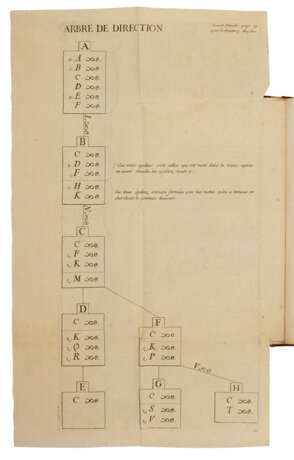ID 887852
Lot 79 | Traité d’Algebre
Estimate value
$ 1 200 – 1 800
First editions. "Although it was his skill in Diophantine analysis that made Rolle’s reputation, his favorite area was the algebra of equations, in which he published Traité d’algèbre (1690), his most famous work ... [It] contains interesting considerations on systems of affine equations. Following the techniques established by Bachet de Méziriac (1621), Rolle utilized the Euclidean algorithm for resolving Diophantine linear equations. He employed the same algorithm to find the greatest common divisor of two polynomials, and in 1691 he was able to eliminate one variable between two equations. The Traité d’algèbre, the language of which is so special, has remained famous, thanks notably to the method of “cascades.” Rolle used this method to separate the roots of an algebraic equation’" (DSB). This copy is unusual in that the leaf Ff2, which is lacking in almost all copies (although the remaining text is continuous), is present. D.E. Smith, A source book in mathematics pp 253-260, containing partial translations into English.
Traité d’Algebre is bound with Remarques de M. Rolle de l'Academie Royale des Sciences, Rolle’s polemic against infinitesimal analysis. "L’Hospital was an honorary academician; in 1696 he had published Analyse des infiniment petits. The Academy was very divided over infinitesimal analysis. Rolle–incited, it was said, by influential persons–vigorously attacked infinitesimal analysis and strove to demonstrate that it was not based on solid reasoning and led to errors ... Varignon defended the new methods and pointed out the paralogisms that Rolle displayed in discussing these examples. The latter, too plebeian to control himself, created an uproar. A commission established to resolve the matter was unable to come to a decision. The dispute lasted from 1700 to 1701, and then continued in the Journal des sçavans in the form of exchanges between Rolle and a newcomer, Joseph Saurin... Rolle was a skillful algebraist who broke with Cartesian techniques; and his opposition to infinitesimal methods, in the final analysis, was beneficial" (DSB).
Quarto, two volumes in one (247 x 183). Two folding plates (one torn, touching one word; lacking front endpaper; some occasional intermittent browning internally, some very faint dampstains at margins; in first volume leaf FF2 is bound at rear). Near contemporary calf (lightly rubbed at extremities). Provenance: Apollonie de la Rochelambert, comtesse de Valon, 1825-1904 (armorial bookplate).
| Address of auction |
CHRISTIE'S 8 King Street, St. James's SW1Y 6QT London United Kingdom | |
|---|---|---|
| Preview |
| |
| Phone | +44 (0)20 7839 9060 | |
| Buyer Premium | see on Website | |
| Conditions of purchase | Conditions of purchase |




